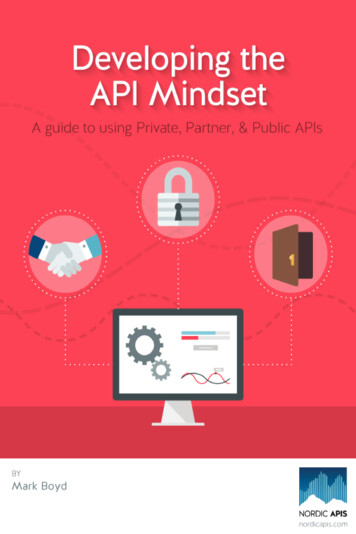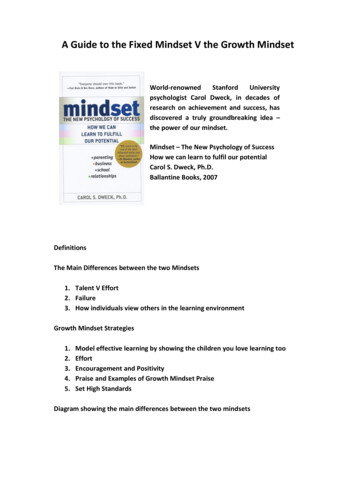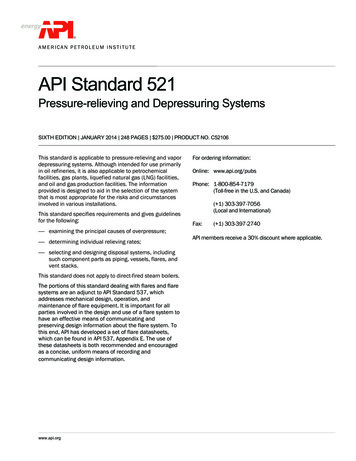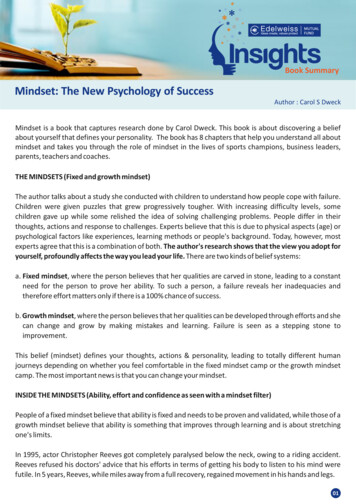
Transcription
Developing the API MindsetPreparing Your Business for Private,Partner, and Public APIsNordic APIs 2015 Nordic APIs AB
ContentsForward: Developing the API Mindset . . . . . . . .iHow to use this E-book . . . . . . . . . . . . . . . . .vDefinitions – An API by any Other Name . . . . . . viiiIntroduction: Choosing Between Private, Partnerand Public APIs . . . . . . . . . . . . . . . . . . .xi1.1 Overview: Why Start with Private APIs . . . . .11.2 Business Benefits of Private APIs . . . . . . . . .91.3 Private API Challenges: When a Private API isNot Private . . . . . . . . . . . . . . . . . . . . . .151.4 Case Study: Bisnode . . . . . . . . . . . . . . . . .181.5 Reflections . . . . . . . . . . . . . . . . . . . . . .212.1 Overview: Building a Successful Partner APIStrategy . . . . . . . . . . . . . . . . . . . . . . . .232.2 Business Benefits of Partner APIs . . . . . . . . .312.3 Partner API Challenges: User Authentication toManage External Access to Data . . . . . . . . . .37
CONTENTS2.4 Case Study: LEGO . . . . . . . . . . . . . . . . . .402.5 Reflections . . . . . . . . . . . . . . . . . . . . . .443.1 Overview: Building a Platform and Ecosystemwith Public APIs . . . . . . . . . . . . . . . . . . .463.2 Business Benefits of Public APIs . . . . . . . . . .533.3 Public API Challenges . . . . . . . . . . . . . . . .593.4 Case Study: Podio . . . . . . . . . . . . . . . . . .613.5 Reflections . . . . . . . . . . . . . . . . . . . . . .664.1 Conclusion: The Roadmap from Private to PublicAPIs . . . . . . . . . . . . . . . . . . . . . . . . . .67Endnotes . . . . . . . . . . . . . . . . . . . . . . . . .75
Forward: Developingthe API MindsetOpen, semi-open, or closed? The degree of an API’s opennesswas the question we had on our minds at the beginningof 2014. We had been running into many people that weredismissing APIs because they weren’t interested in or able tolaunch public APIs. People were coming to our events, butleaving disappointed because they weren’t able to open uptheir services. This recurring phenomenon showed us thatthere was an association in many peoples’ minds betweenAPIs and unfettered data access. We wanted to break thisincorrect stereotype that an API is always a public one.We started this with a series of blog posts that we publishedon our site. It was great to see how engaged people werewith this content. We connected with more and more peopleonline, showing that APIs can also be very useful for internalpurposes and within a partner network.This was a good start, but we wanted to really drive thispoint home and move the industry beyond this incorrectmindset. To this end, we set off on a tour that took us toSweden, Denmark, Finland and Norway. In four days, wemet a couple hundred people who were implementing APIs inthese four cities. We were joined by regional and internationalAPI thought leaders that reinforced the notion that APIsare sometimes public but often private or semi-open. Sincethis Nordic tour, we have held various other events and arei
Forward: Developing the API Mindsetiicommitted to continually publish content that plays a part inthe ongoing development of the API scene. This publicationis an example of this determination.Irrespective of how open or not open your API may end up,this e-book is intended to help you develop a successful APIstrategies. To do this, we show very clearly in this book thatthere are three key API adoption patterns: Private APIs, AKA internal or enterprise APIs; Partner APIs that facilitate integration between a business and their partners; and Public or open APIs.Launching a successful API starts with the right mindset.Should you develop your API for internal use, for partners,for the general public, or a mix of these? Should you planto be closed at first, but then open up over time? What arethe consequences of this strategy? What aspects of your APIprogram should you prioritize at what points? After readingthis e-book, you will be able to answer these questions andmany others. With the correct outlook on how open your APIshould be, you will be able to execute your API strategy withconfidence.As you read this book (and afterwards), check out the NordicAPIs YouTube channel for a deeper dive into the fascinatingpresentations that were shared on our 2014 tour. Also, surfover to our site and make plans to attend an upcoming event.Signup to our newsletter to be notified of new events, e-books,blog posts, and other info.Thanks again, to our sponsors, presenters, participants, andthe online blogosphere for helping build a dynamic, forward-
Forward: Developing the API Mindsetiiithinking business community. I’m very glad to be apart of it,and happy that Nordic APIs can play a part in the API scene.Travis Spencer, Nordic APIs, Co-founder
Forward: Developing the API Mindsetiv
How to use this E-bookOur GoalApplication Programming Interfaces (APIs) are at the centreof a digital transformation that is enabling businesses to domore with less, to reach new markets, and to speed up productand service development time. (See a complete definition ofAPIs in the introduction.)This e-book aims to help maximise the Return on Investment(ROI) you are able to generate through the use of APIs.We will explain the potential entry points for businessesembarking on an API strategy, help you prepare a strategicAPI vision and roadmap, and identify best practices and keyv
How to use this E-bookviresources that have been designed to assist you while buildingyour successful API portfolio.PrerequisitesNo prior knowledge is assumed in this e-book; it is aimed atthree key audiences: Business Developers and Managers who are startingtheir API journey. This applies to those who havemanaged an API pilot project and now want to incorporate an API-driven approach into their organisationalbusiness plan. Developers working within a business, who need aresource guide for best practices. This includes thoseresponsible for ensuring that the API implementationis aligned with an overall business approach. Enterprise architects who lead technological integration efforts. These are the individuals who documenthow processes and technology can be leveraged toimprove business workflows and multiply the impactof the business value chain.Structure of this E-bookThe following is an introductory section on the types orthe category of APIs that can be implemented. Subsequentsections focus on each of these API types in detail, and followthis general outline: A summary overview of the particular type of API
How to use this E-bookvii The benefits of the API type Challenges and security issues to consider when implementing this type of API A case study for each API type showing how businessescurrently implement it A set of reflective questions that prompt you intoconsidering ways to implement the API type, and helpyou use all this new information in a practical way Further resources and community outlets.A final section discusses some of the roadmap and implementation issues facing businesses as they increase the useof APIs in their enterprise. It also assists any businesses thathave started with closed APIs – accessible to a select group ofeither internal stakeholders or to key partners – and explainshow to manage the process of opening these APIs to a wideraudience.Inviting your FeedbackThis is our second Nordic APIs e-book, and we have futureplans to support businesses with a range of other online andprint resources. To help us improve this and future publications, we invite you to share your feedback and thoughts.Please tweet your comments about this e-book using thehashtag #nordicapis. You can also post on our Facebook wall,or email us at info@nordicapis.com.
Definitions – An API byany Other NameAPI stands for ‘Application Programming Interface’. Technically, an API describes how to connect a dataset or businessprocess with some sort of consumer application or anotherbusiness process. Although you may not always recognize afunctioning API, you are probably familiar with a lot of thebig names that use APIs all the time. For example, wheneveryou use your Facebook account to join another site, yourlogin request is being routed via an API. Whenever you usethe Share functions of an application on your mobile device,those apps are using APIs to connect you to Evernote, Twitter,Instagram, etc.In addition, when you are accessing a location data, or performing a state-abbreviation or postcode lookup in cloudcomputer software, the function is often accomplished bythe cloud service calling an API. Frequently, APIs are theconnectors that are doing the heavy work of moving data andperforming specialized capabilities. We may not be aware ofthis, because they are performing behind the scenes.The sidebar, API Examples briefly illustrate other possiblefunctions an API can perform.API Examplesviii
Definitions – An API by any Other NameOne common example is a mapping API. When yousearch for an address, an API helps interact with a mapdatabase to identify the latitude and longitude, and otherrelated data, for that address. The API also makes itpossible for a mapping interface to then display theaddress on the map, and any additional information suchas the directions to that destination.An API could also do things such as route machine datato a program that will automate the analysis of that inputand send certain messages depending on the results. Inthis scenario, the API ensures that the data is in a formatthat can be understood clearly by a computer program(i.e. it is “machine readable”). APIs help you monitordata automatically, and share it only if something specialhappens.An API can assist you in recognising when someone hasplaced an order on a website. It may then monitor theorder data to see if information needs to be forwarded tosomeone responsible for same-day shipping, or whetherit should be sent to the normal shipping delivery queue.Finally, imagine an API that can make it easier for abusiness to pull relevant data out of a database andadd it to a useful report. The API provides a commonformat that allows different applications to speak to oneanother. You can also use an API with reporting softwarethat must display the extracted data in a usable format.As you can infer from the many examples of APIs, theseservices are much more than just a description of howto access a database or how to help a machine read thedata. APIs enable a business to become a platform.APIs help you break down your business products andix
Definitions – An API by any Other Nameservices into composable functions you can share withother businesses for direct insertion into their processes.APIs provide a way for businesses to leverage newmarkets. APIs allow partners and third-party developersto access a business’ database assets, or create a seamlessworkflow that accesses a business’ services.For example, by opening up a business’ product catalogue via an API, online retailers could include thatAPI provider’s products in their marketplace. This wouldallow such a business to reach new customers in newmarkets. A further example might be a business thatprovides printing services. By exposing this core serviceas an API, a third-party app developer could offer aprinting service directly from their mobile apps, helpingthe printer reach new audiences. In this case, the appdeveloper doesn’t provide the printing service; they justroute the request via an API through their app to theprinting business, which charges and manages the service request.**An API is also a legal contract. **API documentationincludes a ‘terms of service’ agreement. This explainshow data can be used, and any costs associated with therequests the consumer makes via the API. In this manner,a business can stipulate how their data or services can beused by commercial and third-party developers. It alsoestablishes a pricing mechanism for use of the data orfunction exposed by the API.In all of these examples, the company providing theAPI must decide how open they wish their API to be.Generally speaking, there are three degrees of opennessthat a business may adopt.x
Introduction: ChoosingBetween Private,Partner and Public APIsAPIs enable businesses to funnel data and services across theirorganisation and to their wider network of suppliers, partnersand end customers.Releasing a Public API can also have a long-term effecton customer loyalty. Customers who use a business’ APIare likely to spend more and remain a customer for longer.This happens because they are embedding the API provider’sservices and products into some part of their own businessvalue chain.Understanding and identifying the different benefits andlimitations of Private, Partner and Public APIs is a conversation currently being held amongst industry stakeholdersall around the world. It is a conversation being picked upby existing businesses outside of the internet and Cloudbased startup circles. The discussion is widening becausexi
Introduction: Choosing Between Private, Partner and Public APIsxiimore organisations are seeing that a view of APIs througha Private/Partner/Public lens can provide a more concreteunderstanding of what businesses really need to know whenembarking on an API strategy. To see how this vantagepoint can be helpful, let’s examine these three degrees of APIopenness.Private API ModelsTwo types of Private APIs can be utilised within a business.The first type are those that are set up internally to link twodatasets or processes together. These are paired with businesslogic in a very tight manner. This type of Private APIs areoften set in place by a top-down management process, andtheir use is enforced behind the scenes by an IT department.This type of Private API may also be used to expose abusiness’ data to its own mobile applications. In this case, thePrivate API makes it possible for a business to access its datathrough a mobile interface, such as an iPhone app. The APIlets a business get out from behind the desktop (or laptop) andprovide access to the data from any remote device.The second type of Private APIs are those akin to Webservices, provided as a part of a Service-Oriented Architecture(SOA). This kind of Private API provides an integration component that is made available to anyone within the business.They encouraged and facilitate reuse. This can often be abottom-up or horizontally-instituted API strategy. An API ofthis type is created to encourage other departments to sharedata or processes, and to facilitate team collaboration acrossthe business. This forms a sort of private library of APIs.These can include self-paced resources that inform internal
Introduction: Choosing Between Private, Partner and Public APIsxiiidevelopers across an enterprise on how they can use an APIto integrate and consume data source or business service.Private APIs of either sort are often the preferred startingpoint for many businesses. For businesses seeking to extendtheir existing service-oriented solutions, the ability to automate internal data usage, and reduce duplicated processingof information across departments, is a natural starting point.Private APIs also have the advantage of not overexposingthe business as it learns about APIs. A strategy that beginswith the launch of Private APIs allows a business to seewhere their APIs are inadequate, or where difficulties occurwhen using their APIs themselves. This is preferred becauseany failures may occur will only affect the API provideritself. Conversely, businesses that initially expose APIs topartners and customers may lose their trust if the partners orcustomers are inconvenienced by an improperly functioningAPI.In and of themselves, Private APIs create multiple benefitsfor businesses, without the need to open up the API anyfurther. Private APIs are at the core of a business’ digitaltransformation, and generate efficiencies and productivityimprovements across a business’ operations.While Private APIs allow a business to learn through experience, it is no short cut. Private APIs require resourcing inorder to create the productivity gains that are promised inan API-enabled environment. This may mean providing asuite of user services, for example, documentation, SoftwareDevelopment Kits (SDKs), training videos, and detailed errormessaging. These should assist internal developers to successfully integrate an API into their business functions.
Introduction: Choosing Between Private, Partner and Public APIsxivPartner API ApproachesTo leverage business relationships in a distributed environment, companies are also beginning to turn to partner-basedAPIs as a way of collaborating effectively. This allows partners to utilize the customer relationships of one businesswith another. For instance, the Swedish Digital PR agency,Deportivo, uses the APIs exposed by various Cloud providersto facilitate partnership communication. Deportivo’s Art Director, Arvid Dyfverman, said the agency uses APIs fromproject management tools like Trello and Basecamp to involvepartners in their creative design projects.Danish business network platform, Tradeshift, has created aPublic API to help customers more easily integrate businessnetworking services into their legacy systems. To help endcustomers achieve this, Tradeshift has also created a suiteof Partner APIs that are designed with the end customer inmind. As a result, the Partner APIs enables broader adoptionof the company’s Public APIs. This type of multifaceted APIstrategy is indicative of one developed by an organisation thathas progressed beyond one of API provider to that of an APIplatform.Public API ReleasesPublic, or open APIs, can rapidly grow a business’ marketshare and customer base. Swedish online retailer Fyndiq, forinstance, found their sales volumes per month grew significantly after making their product catalogue available via API.Once they launched their API, their problem became keeping
Introduction: Choosing Between Private, Partner and Public APIsxvup with sales, not getting sales, co-founder and CTO, MicaelWidell, told Nordic APIs readers.Other companies are finding they can monetize their APIas a new commercial product or service, with developercustomers willing to pay for access to the stream of data orfunctionality opened up via an API.Tom Burnell, from API management provider, Axway, shareddetails of several Nordic businesses that are opening up theirdata and capabilities via public-facing APIs. He points toEssent, the Swedish energy company that uses APIs to helpcustomers optimize their energy usage. Nordic telecommunications company, 3G, is using APIs to allow customers to topup their prepaid phones. This is creating a new direct revenuechannel for them in addition to their existing model that reliedon sales made solely through value-added resellers.Meanwhile, some of the Nordics’ fastest-growing online businesses, such as Moves in Finland, Spotify in Sweden, andPodio in Denmark, are making use of Public APIs as part oftheir hyper-growth strategies.The Origin of your API JourneyIt is often said that businesses can expect very high impactsfrom releasing Public APIs. In reality, however, it will mostlikely take an extensive period of time to build recognitionand adoption of your API among third-party developers. Thisis clear when you consider it likely that you must more or lesscoax an ecosystem into existence.While Private APIs make sense for automating data processesand encouraging collaboration in larger businesses, it is Partner APIs that have a high potential for quickly generating
Introduction: Choosing Between Private, Partner and Public APIsxvipositive business impacts. Depending on the size of the enterprise, it may be the best starting point for a business’ APIstrategy.Beginning with a public-facing API is recommended withcaution. As mentioned before, there are a lot of opportunitiesto learn from deploying an API internally or with partnersfirst. This is important as trust can be lost so quickly. Thedetrimental effects of accidentally exposing a third-party’sbusiness data could immediately undo any adoption or recognition you have gained for your API. Starting with Privateor Partner APIs will also help a business identify the normalrange of API consumption. This makes it easier to makeaccurate capacity plans and set appropriate rate limits, soresources are not overused by low-priority consumers. It alsohelps to monetize high-end users as you pivot to a public APIrelease.The following sections shares how Nordic businesses are implementing business-wide API strategies and offers guidancefor businesses anywhere in the world who are seeking thebenefits of each of these three categories of API.Additional Resources The rise of the API economy andconsumer-led ecosystems
1.1 Overview: WhyStart with Private APIs“While each business and situation is different, we’ve seenmany organisations choose to launch a private or partnerAPI rather than a public one out of the gate,” says RonnieMitra, Director of API Design at CA Technologies. Startingwith a Private API addresses the reluctance and concernssome businesses have when starting their API journey. Thesefears are lessened by Private APIs because they ensure thatan organisation can: Make mistakes and changes behind closed doors; Staff up on the resources needed to properly supporta public API offering after obtaining success with aprivate one; and Realign the business to benefit fully from the effects ofan open API.1
1.1 Overview: Why Start with Private APIs2Ronnie added that “many API owners have longer-term visions of opening up APIs to the public and use a closed API asa springboard.” He says that this closed-first-open-eventuallystrategy results in the infrastructure build-out required tosolve longer-term needs of the business. Ronnie also pointedout that product owners often have an eye on the future, anduse this initial foray into APIs to incrementally expand to abroader audience.Even without a clear case for eventually opening up anAPI, a Private API approach can add significant benefits toa business. For example, any process that requires data tobe copied from one system or process to another can beautomated via an API. This has the advantage of reducinghuman errors that may be introduced when moving data fromone place to another. Automation also improves productivityby alleviating the need for duplicate tasks. Using Private APIsfor internal data transfer also reduces errors introduced whenmultiple versions of a dataset are strewn across an organisation. Reliance on a Private API improves data integrity andreduces clutter.APIs can also be used to speed up process and authorisationmovements across a business. For example, businesses oftenhave accounting policies that require appropriate authorisation for anyone purchasing above a certain amount. PrivateAPIs can be used to trigger workflow approvals automatically, reducing risks and workload in moving tasks along abusiness’ operational flow.Private APIs are similarly used in new product and servicedevelopment. Private APIs can trigger automatically whenother departmental teams or stakeholders need to be involved.This action can make a set of common resources available to
1.1 Overview: Why Start with Private APIs3everyone involved in the production teams.Focus on User ExperienceOne goal of a Private API is to ensure that it is tightlycontrolled and will restrict access only to internal users.Thinking about Private APIs in this way can help lower thepriority of API usability. Private APIs often have a poor userexperience. This should not be the case. In a manner similar tothe way a company’s intranet is often much less user-friendlythan their public-facing website, Private APIs tend to neglectthe developer experience.Research data from Nielsen Norman shows that companiesinvesting in intranet usability receive productivty increasesworth eight times the design costs required to achieve them.Research indicates that this factor increases for larger com-
1.1 Overview: Why Start with Private APIs4panies. The same sort of productivity benefits can be hypothesized about an investment in the design of usable PrivateAPIs. While not proven through similar research, the correlations are strong enough to suggest that new users can makethe most of the private APIs when focusing on the followingareas: API design,Documentation,Error handling,Testing,Inclusion of SDKs, andInternal knowledgebases.A Common Approach to PrivateAPIsWhen a use case identifies the advantage of a Private API, itis important to consider other potential uses of the dataset,or functional capability exposed by the potential API. Thisensures that APIs are not created for each individual use case.If each one is unique to a given problem, the enterprise willbe encumbered by the initial APIs as it continues along itsAPI journey. This generalization of an API can also help avoiddataset duplication and ensure consistent API design practicesare adhered to across APIs. This is important because in manysuccessful cases Private APIs are opened up to a wider userbase than originally expected. In the case of legacy APIs it isespecially important to follow this practice to avoid problemsand tying up developer resources.
1.1 Overview: Why Start with Private APIs5Businesses often repeat the same problems when trying toopen up their datasets via APIs. Depending on which systemis used, the data can have different names, allow differentstring length, or have different identifiers. Michael Widellfrom e-commerce vendor Fyndiq says this is one of the benefits of starting with Private APIs: you can focus on makingsure the data you expose has consistent naming conventionsand other formatting rules. If you expose the data via an API,you can manage the formatting and naming in one place – theAPI – as you scale the usage to partners or the general public.Identifying Internal API Use CasesAnne-Sofie Nielsen from enterprise, data-scraping company,Kapow Software, has seen how her business customers areusing internal APIs to create efficiencies and to encouragestaff to concentrate on more interesting, useful work. “If youautomate internal processes there are cost savings,” she says.“Whenever you eliminate people having to manually updateor extract information from internal systems, it’s a prettyeasy calculation to see how many resources you free up. Inmany cases, companies have more productive things theiremployees could be doing, which ultimately enables them togrow revenue,” Anne-Sofie further explains.She has seen how some customers have used APIs to significantly reduce burdensome data transactions between internal and external systems. “Obviously there are cost savingsfrom reducing the customer support response times from, inone customer’s case, ninety minutes to approximately fourminutes.” However, she adds, “but I am sure that will alsohave a long-term effect on their customer’s perception of
1.1 Overview: Why Start with Private APIs6the company, which will have effects on customer retentionnumbers.”Anne-Sofie shared with attendees of one of our events inCopenhagen how her customers are using internal APIs thatfollow a basic principle: Use people to accomplish what acomputer cannot do as well. As she explained in the recordedversion of the presentation, “Let’s put humans to work wherewe need human minds, and let’s automate the rest. This freesup resources for higher-value tasks.” This could include: HR automating manual reporting processes HR extracting data on current salary levels in othercompanies’ job ads to be able to make market-competitivesalary offerings to new candidates IT automating complex workflows around defect tracking Accounting automatically validating partner rates versus client rates, using humans when exceptions ariserather than having to audit every invoice.Robust Private APIs BecomePartner APIsAt Finnish software company PlanMill, the first twelve monthsof using the API was a period of uncertainty. MarjukkaNiinioja, Senior Consultant and Manager at PlanMill, saysthat staff were unsure how to sell the API features to partnersand customers. They were also initially unclear on how toprovide the best usability and ensure supportability withregard to testing, API key registrations, documentation, and
1.1 Overview: Why Start with Private APIs7other factors. They learned these things incrementally byusing the API themselves. This so-called practice of “eatingyour own dog food” gave the PlanMill team a deep insightinto the potential and power while also helping them buildawareness of the drawbacks and challenges of using their APIbefore it was integrated with partner systems. “I never want tosee dog food again,” Marjukka joked when presenting to ourHelsinki event audience about the steep learning curve. It wasworth it though, she added. Because of their initial internaltesting, their eventual public API was better designed. Latertesting and usage was not such hard going, and they were ableto “swap from dog food to donuts!”To encourage internal stakeholders to integrate their systemsvia the API, Marjukka repeated several mantras whenevertalking with her colleagues: Who has some great examples of using our API?Have you tested that with the API?Have you added that to the API documentation?You can do this quicker and cheaper using our API.Getting Started with Private APIsPrivate APIs may well be the best way for some enterprisesto commence their API strategy. Starting with internal APIscan help identify the best integration pathways. In addition,this approach lets you design a roll-out strategy that will encourage ownership and commitment from across all businessoperations.One of the best places to start is by asking staff to identifythose occasions when they have to cut and paste data from
1.1 Overview: Why Start with Private
HowtousethisE-book vii ThebenefitsoftheAPItype tingthistypeofAPI .











